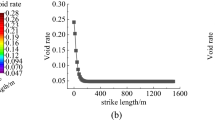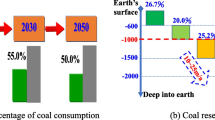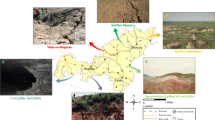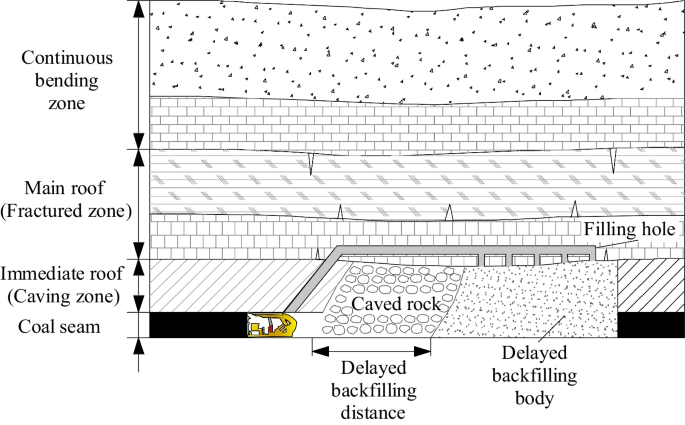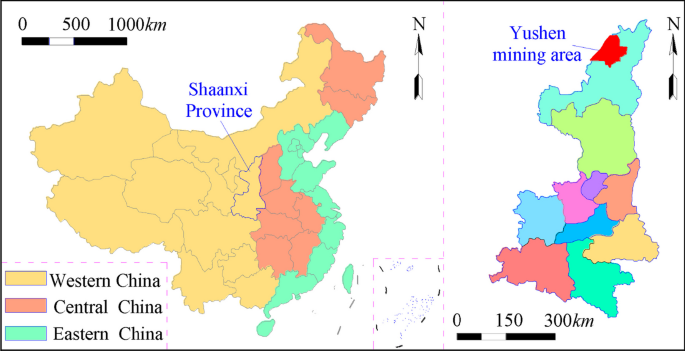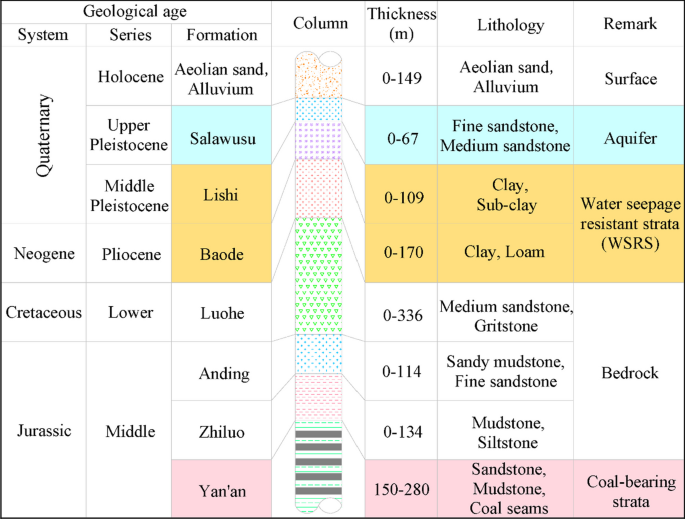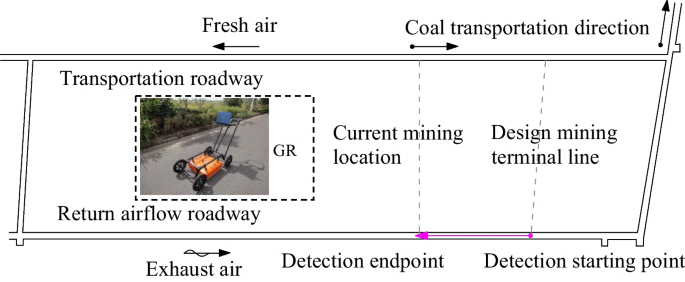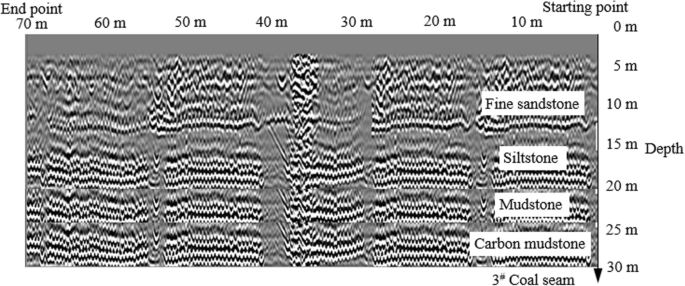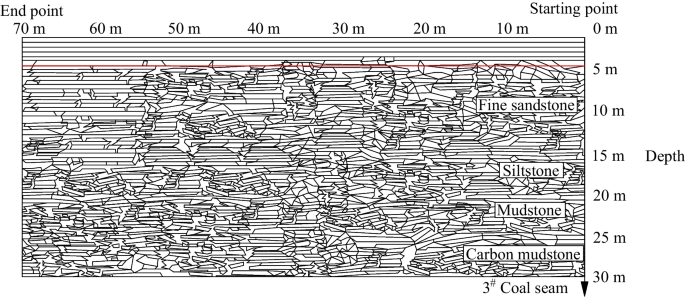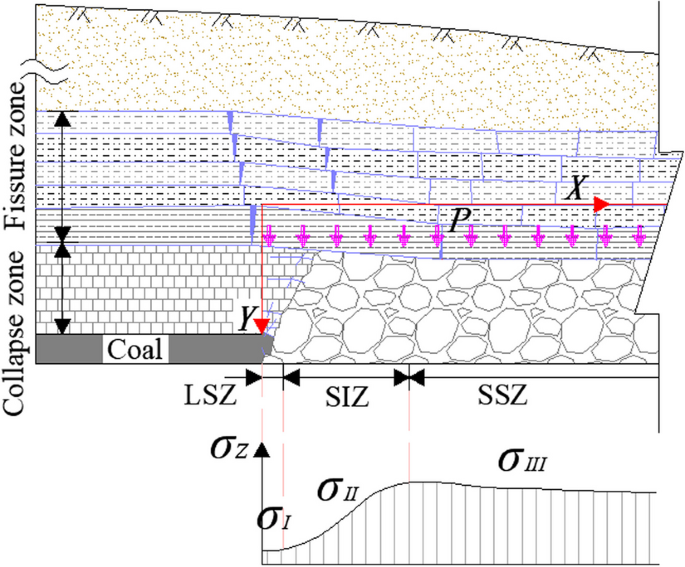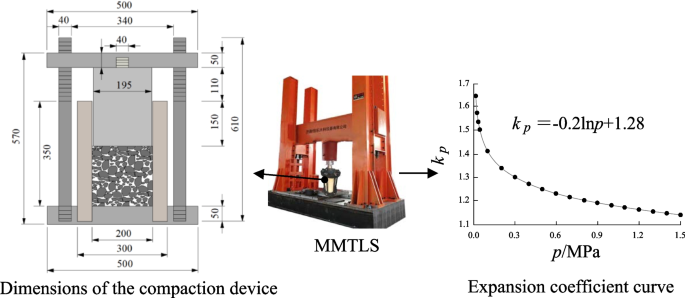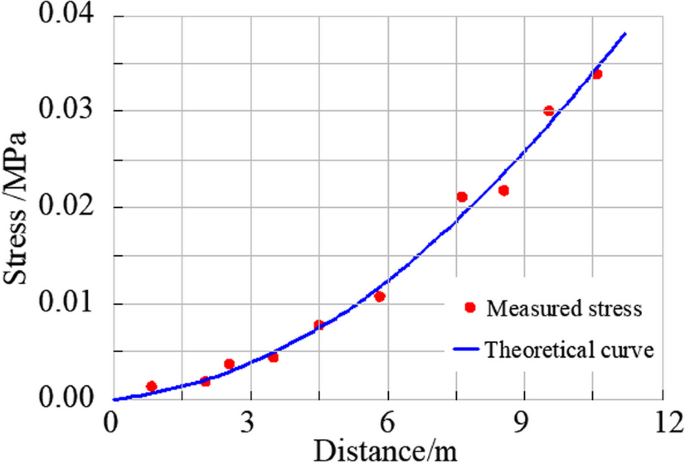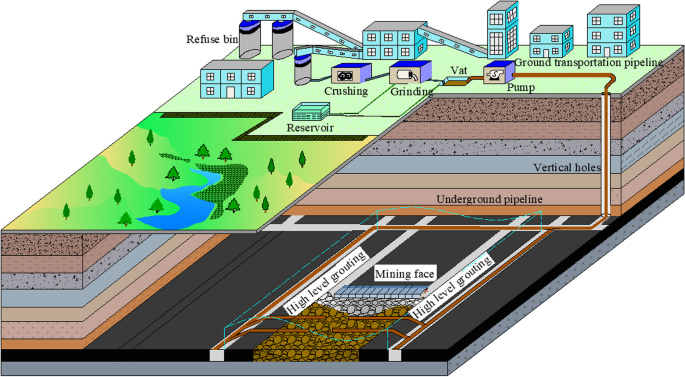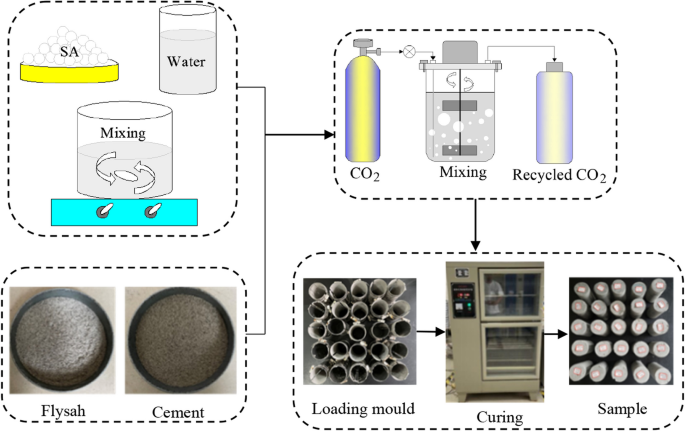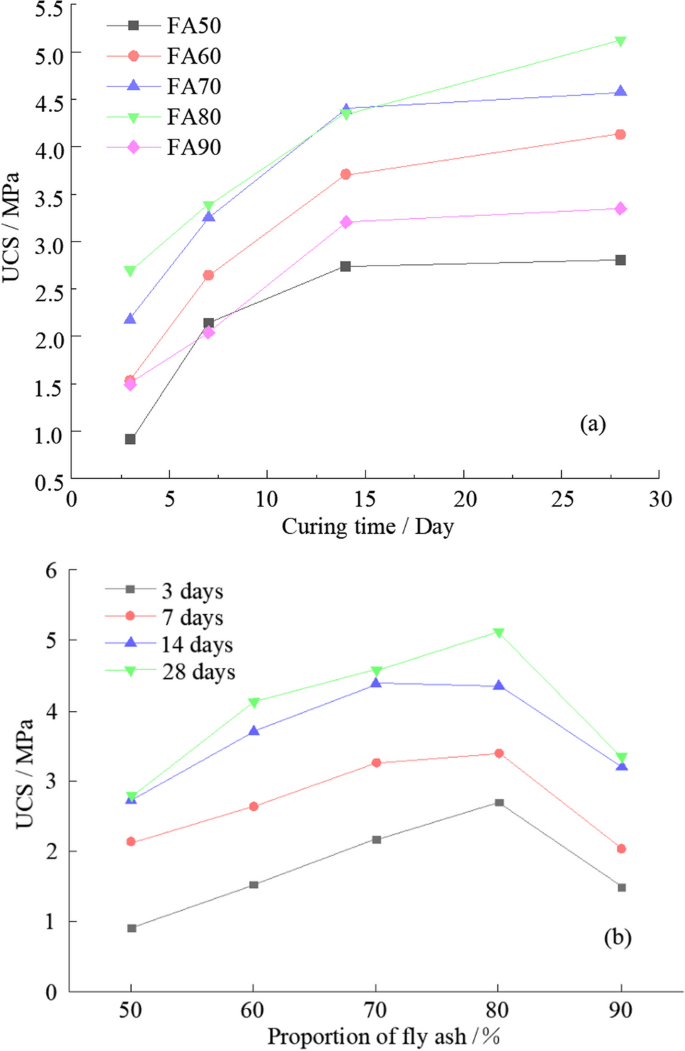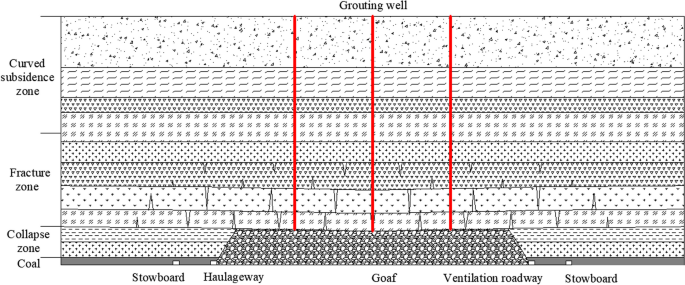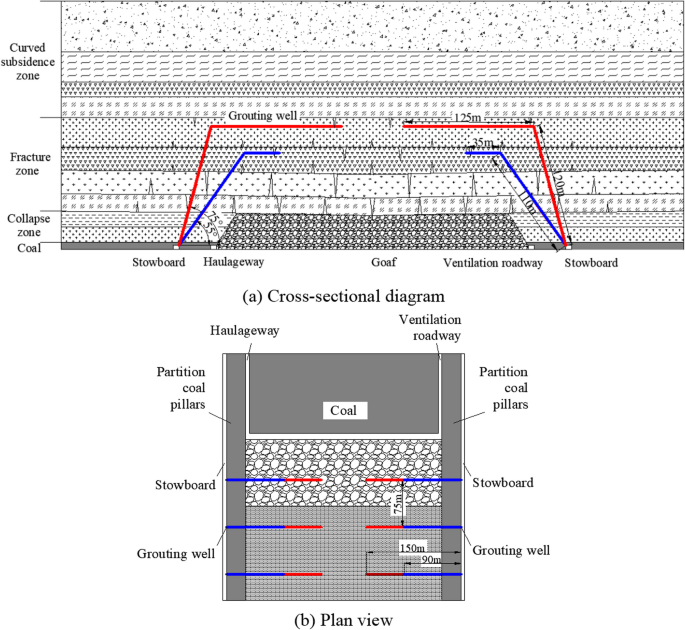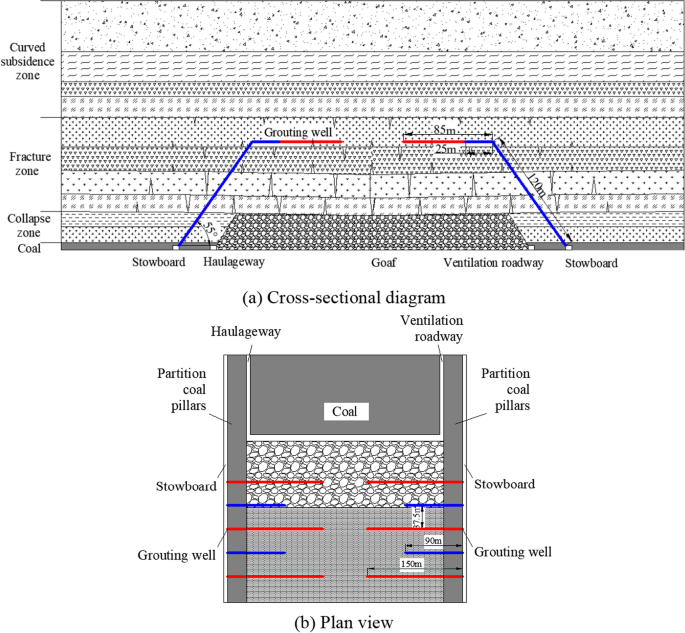Abstract
Underground backfilling stands out as a crucial technological strategy for the eco-friendly and effective management of solid waste in mining operations. However, existing backfilling techniques have led to increased production processes at the working face, resulting in a reduction in coal extraction efficiency. Addressing the temporal and spatial interference between mine solid waste backfilling and coal mining is essential. To overcome this challenge, this study introduces a novel post-mining spatial gangue slurry backfilling method. Radar detection was employed to ascertain the typical characteristics of the subsequent space collapse roof shape. Stress monitoring and compaction experiments were conducted to establish the relationship between stress and the bulking coefficient of the overlying rock mass, identifying subsequent spatial void structure characteristics. The development of a CO2 mineralized coal-based solid waste filling material, utilizing conventional low-calcium fly ash under normal temperature and pressure conditions, was presented. This paper provides a comprehensive understanding of the post-mining spatial gangue slurry backfilling method, outlines the spatial layout approach for the corresponding system, and analyzes research challenges associated with gangue slurry backfilling materials and the technology of slurry injection borehole layout. The research aims to innovate an efficient underground disposal model for gangue, contributing to the refinement of the technical system for the comprehensive disposal and utilization of gangue.
Similar content being viewed by others
Introduction
Coal is one of the primary sources of energy worldwide and plays a significant role in economic development (Zhang et al. 2019a, b, c; Gao et al. 2018). The healthy development of the coal industry is crucial for energy security and sustainable economic growth (Chen et al. 2020a, b; Xu et al. 2020). While coal has made tremendous contributions to industrial development, it has also brought a series of environmental damage issues, significantly impacting surface ecology and groundwater environments, particularly in ecologically vulnerable areas (Singh and Guha 2018; Li et al. 2019). The contradiction between large-scale coal extraction and environmental protection is particularly pronounced in areas characterized by coalfields with thick coal seams, shallow burial, limited water resources, and fragile ecosystems (Wang et al. 2018a, b, c; Chen et al. 2020a, b, 2021; Zhong et al. 2019). In response to the ecological damage caused by large-scale mechanized mining methods, the current scientific development strategy for coal resources needs to shift from “passive restoration” to “active protection” and from “intensive mining” to “harmonious coordination” (Zeng et al. 2019; Liu et al. 2020).
Due to the limited conditions for coal occurrence, around 90% of coal in China is primarily extracted through underground mining (Wang et al. 2019; Huang et al. 2022; Qi et al. 2019). In accordance with the overall requirements of ecological civilization construction and prioritizing environmental protection, as well as emphasizing natural restoration, efforts should be made to minimize and control the ecological damage caused by mining operations underground. Currently, the main methods used to prevent ground ecosystem disruption resulting from coal mine strata collapse are pillar extraction and backfill mining (Zhu et al. 2018; Zhang et al. 2017a, b; Wang et al. 2018a, b, c). However, the pillar extraction method leads to resource wastage and reduces the service life of mines. It also affects production layout and efficient coal recovery (Bai et al. 2022b; Li et al. 2016). On the other hand, traditional backfill mining incurs high costs and poor economic viability, making it unsuitable for large-scale promotion and implementation by coal mining enterprises (Wang et al. 2018a, b, c; Yu et al. 2020a, b; Shao et al. 2020). Therefore, it is crucial to explore a comprehensive, scientifically sound, and efficient coal mining technique that minimizes subsidence and ensures water preservation, which is a vital and practical requirement for green and efficient mining at the current stage (Meng et al. 2021; Hou et al. 2021; Yuan et al. 2021).
In underground mining, longwall mining method, compared to other mining methods, enables continuous coal extraction and possesses advantages such as high productivity, efficiency, recovery rate, and strong applicability (Zhang et al. 2017a, b; Liu et al. 2023). Consequently, it has been widely applied and developed. However, the damage caused by longwall mining to the surface and groundwater in mining areas should not be underestimated (Doulati et al. 2022; Bai et al. 2022a). Since most longwall mining methods primarily adopt the full caving method to manage the roof, the roof collapse area is extensive, resulting in significant displacement and deformation of overlying rock layers from the coal seam to the surface (He et al. 2015; Bai and Tu 2019). In cases where the coal seam is close to aquifers or surface water bodies, mining-induced fractures may penetrate the aquifer sealing layers, leading to water resource loss and sudden inrush of water in working areas, thereby triggering a series of ecological, environmental, and production safety issues (Gao et al. 2019; Yu et al. 2020a, b; Hu et al. 2018). The various environmental and safety problems caused by underground coal mining essentially revolve around the loss of water resources induced by mining operations (Li et al. 2020; Xu et al. 2019).
Backfill mining is an effective method that limits the impact on water, soil resources, and infrastructure within the tolerable range of ecological tolerance for mining activities (Liu et al. 2018; Hu et al. 2017a, b; Chen et al. 2019; Zhang et al. 2020a, b). Promoting advanced technologies such as efficient backfill mining in an adaptable manner and conducting feasibility studies on coal mine backfill mining are among the key tasks for comprehensive management of mining subsidence areas (Zhao et al. 2019; Ma et al. 2018; Zhang et al. 2019a, b, c; Wang et al. 2020). Backfilling the goaf is currently one of the most effective approaches to water conservation in coal mining (Liu et al. 2019; Zhang et al. 2020a, b; Xie et al. 2016; Xu et al. 2017). However, traditional goaf backfilling encounters challenges such as insufficient time and space for timely backfilling before the roof collapses after coal extraction (Chen et al. 2018; Yang et al. 2017; Wu et al. 2016; Zhao et al. 2020). Additionally, mining and backfilling operations occur within the same limited space, making it difficult to coordinate parallel operations and causing backfilling to affect mining progress (Zhang et al. 2019a, b, c; Shi et al. 2019; Hu et al. 2017a, b; Wang et al. 2021a, b). In coal mining environments characterized by complex geological conditions, a specialized approach to backfill mining has been implemented. This practice entails utilizing materials like gangue, sand, and crushed stone to fill the goaf, with the primary objective of minimizing subsidence associated with the mining process (Yang et al. 2019; Jiang et al. 2018; Liu et al. 2021). However, whether using coal gangue backfilling, cementitious backfilling, partial substitution of fly ash for cement in backfilling, or concrete backfilling, the unit cost is generally high. The relatively high investment cost significantly impacts the economic benefits of enterprises and objectively limits the widespread application of this method.
Regarding this particular situation, the authors propose a delayed backfilling approach for goaf filling. The backfilling operation is delayed compared to the mining operation, allowing for the natural collapse of the goaf roof. This results in a completely or nearly completely filled goaf area formed by the natural collapse of the goaf roof after coal mining. The authors utilize the fragmentation and expansion properties of the collapsed rocks. On the side close to the working face, a designated delayed filling zone is determined. Through directional drilling or upper-level roadways near the working face, the voids in the collapsed zone are grouted before compaction, consolidating the collapsed zone to form a load-bearing structure with certain strength, as depicted in Fig. 1. Radar detection was utilized to characterize the typical shape of the roof collapse in the subsequent space. Stress monitoring and compaction experiments were carried out to establish the correlation between stress and the bulking coefficient of the overlying rock mass, revealing the characteristics of the subsequent spatial void structure. The paper introduced the development of a CO2 mineralized coal-based solid waste filling material, employing conventional low-calcium fly ash under normal temperature and pressure conditions. It systematically elaborated on the concept of the subsequent space gangue grouting filling method and provided the spatial layout approach for the subsequent space gangue grouting filling system. The challenges in the development of gangue grouting filling materials and the technology for grouting borehole layout were thoroughly examined. The backfilling volume and range only cover a portion of the mined-out space. After reinforcing the collapsed rock mass with backfill material, it supports the overlying strata and achieves the objectives of controlling strata movement and water conservation while mining proceeds parallelly. The advantage of this method is that it separates the mining and backfilling processes, avoiding interference between them. Based on field investigations, the authors provide a detailed analysis of the characteristics of the collapsed goaf roof and the height of the collapsed zone, establishing the boundaries for grout filling. By monitoring the stress of the goaf in real-time, a stress distribution model for the delayed filling zone of the collapsed rock mass is established. This provides theoretical support for determining the timing of delayed grout filling in the collapsed goaf and understanding the development patterns of overlying strata fractures in the delayed filling zone.
Study area and hydrogeological conditions
The Yushen mining area is located in the arid inland region of central and western China, characterized by scarce water resources, making it a typical ecologically fragile mining area (Fig. 2). Groundwater in this region mainly relies on atmospheric precipitation, with an annual average precipitation ranging from 248.7 to 724.9 mm and a long-term average precipitation of 471.5 mm. Due to the terrain and landform, most of the precipitation forms surface runoff and is lost, with less than 15% infiltrating into the rock and soil layers. Moreover, the area experiences a high average annual evaporation of 1611 mm, leading to severe water shortage (Ma et al. 2022). In the early twenty-first century, the Yushen mining area began adopting modern coal mining technologies such as large working faces and one-time full-height mining. Due to the shallow burial of coal seams, thin overlying bedrock, and thick wind-blown sand cover on the surface, this high-intensity, integrated mining leads to deformation and fracture zones known as “double zones.” The structural damage to the aquifers results in the infiltration of water from the bedrock aquifer and the loose water-bearing layers of the Quaternary system into the goaf. This has caused a series of mining environmental geological effects, including leakage of underground water resources, sudden inrush of water and sand underground, groundwater level decline, and degradation of the ecological environment. The original fragile ecological environment of the mining area has become even more difficult to restore. For example, on July 13, 2003, when the 1310 working face in the Dalitata mine advanced to a position 16.7 m away from the cutting eye, the roof collapsed completely, leading to a geological disaster of water inrush and sand outburst, with a maximum water inflow of 510 m3/h (Ma et al. 2022). According to the statistics of water inflow in the Yushen mining area in recent years, the average water inflow of the Dalitata, Bulianta, and Shigetai mines exceeds 13,000 m3/d. The maximum water inflow is 16,853 m3/d (Shigetai). The average flow rate of the Mother River Spring Domain in the Dalitata mining field was 5961 m3/d before coal mining, with a maximum average flow rate of 106,273 m3/d (Fan et al. 2018). However, in recent years, due to the damage and drainage of the Quaternary water-bearing layer caused by coal mining, the flow rate of the Mother River Spring Domain has decreased to only 1680 m3/d, a reduction of 72% (Song et al. 2021). Protecting and utilizing groundwater resources in coal mining has become an urgent issue in the scientific development of coal resources in ecologically fragile areas of central and western China.
The project proposes the technique of delayed backfilling for low-carbon water-conserving mining in goaf areas. It determines the space for delayed backfilling in goaf areas, the layout of grouting holes for backfilling, and parameters for delayed grouting and backfilling. The main contents include the fragmentation characteristics of collapsed rock blocks in goaf areas, the initial distance for delayed backfilling, the ultimate distance for delayed backfilling, the stratigraphic position for delayed backfilling, the arrangement of surface grouting holes and underground grouting holes, hole spacing, hole structure, and grouting volume.
The typical comprehensive stratigraphic column of the Yu-Shen coal area and the lithological characteristics are shown in Fig. 3. The surface is primarily covered by Quaternary strata, and bedrock outcrops are sporadically distributed in valleys. The mining area is defined within the coal field, and it comprises six mineable coal seams at various depths. The total estimated coal resources amount to 1.24 billion tons, with a remaining reserve of 1.19 billion tons. The designed production capacity of the mine is 8 million tons per year, and the expected mine service life is 67.9 years. As of October 2021, the mining operation has completed the extraction in the 301 panel area, including ten working faces (30,101–30,110), and the extraction is ongoing in the 302 panel area, specifically in the 30,201 working face. In the next three years, the mine plans to extract from the 30,201 and 30,202 working faces. The 301 panel area adopts a multi-slice longwall (MSL) method with a mining height of 5 m, while the 302 panel area plans to use a single pass longwall (SPL) method with a mining height of 7.2 m.
Based on the groundwater occurrence conditions and hydraulic characteristics, they are divided into two types: the Quaternary loose rock porous confined aquifer and the Jurassic Middle System Zhijialu Formation and Yan'an Formation sandstone fractured confined aquifer. From top to bottom, it can be divided into five aquifer layers (formations): the Quaternary Holocene alluvial layer porous confined aquifer, the Upper Pleistocene lacustrine layer porous confined aquifer, the Quaternary Middle Pleistocene loess layer porous fractured confined aquifer, the Jurassic clastic rock weathered crust fractured aquifer, and the clastic rock fractured confined aquifer. The aquitards mainly consist of Quaternary Middle Pleistocene relative aquitard and the mudstone and sandy mudstone aquitard between the Jurassic sandstone layers (Table 1).
Upon analyzing the distribution characteristics of aquifers in the mining area, two main types of aquifers were identified: the loose rock mass aquifer with pore and fissure water in the Quaternary system, and the fractured rock aquifer in the Jurassic clastic rocks. As for the distribution characteristics of aquitards in the mining area, two major aquitards were identified: the relative aquitard composed of middle-lower Quaternary loess in the Quaternary system and the interbedded aquitard in the Jurassic bedrock. Current research indicates that the focus of water hazard prevention and control lies in ensuring safe mining operations by minimizing the inflow of water from the roof during the mining process. Properly controlling the position of the interface between the water-conductive fractured zone and the aquifers based on the hydrogeological conditions of the mined coal seam and preventing damage to the aquitards caused by mining activities are essential approaches to achieve water-conserving mining practices.
Field detection of collapsed roof form
The detection area is the goaf of the No. 3 coal seam in the 301 panel area. The ZTR12 series geological radar (GR) utilizes shielded antennas to emit high-frequency electromagnetic waves ranging from 1 MHz to 2.5 GHz, while the receiving antennas collect the corresponding signals, which are then stored and displayed by a computer. The ZTR12 series GR has a central antenna frequency of 100 MHz, a length of less than 1 m for each individual antenna, a step size smaller than 2 × 10–12 s, an output signal of 10 × 10–9 s, and a voltage of 90 V. Additionally, when generating a 100 MHz transmission pulse, the amplitude ratio between the pulse and ripple increases significantly to over 30 dB, allowing the effective mapping depth of the GR to reach within a range of 30 m below the No. 3 coal seam, making it fully applicable in underground mining environments. The ZTR12 series GR was employed to detect the roof strata of the goaf in the No. 3 coal seam. The GR has a detection depth of 30 m and a detection distance of 70 m. The detection area is illustrated in Fig. 4, and the GR system conducted tests at 1024 sampling points.
The GR detection data collected were processed through zero-point calibration, denoising, filtering, and gain adjustment to obtain the GR detection images. These images clearly reflect the collapse status of the roof strata after coal seam extraction in the detection area, as shown in Fig. 5. From Fig. 5, it can be observed that within a distance of 30 to 70 m from the detection starting point, there are four distinct alternating strong and weak reflection zones. Specifically, a weak reflection zone appears in the 60 to 70 m position, and its phase is generally consistent with the surrounding medium reflection image. Therefore, the black dashed-line area represents a mildly damaged region where the roof exhibits minor fragmentation and relatively high integrity. On the other hand, a strong reflection zone appears in the 50 to 60 m positions, and its phase differs from the surrounding medium reflection image. Hence, the white dashed-line area represents a severely damaged region where the roof exhibits significant fragmentation and poor integrity. This cyclic pattern of alternating reflection zones follows the advancing direction of the working face and is in basic agreement with the results obtained from on-site borehole observations. Based on the aforementioned detection results, the collapsed morphology of the roof in the goaf of the No. 3 coal seam was reconstructed, as shown in Fig. 6.
From Fig. 6, it can be observed that after the extraction of the No. 3 coal seam, the immediate roof (carbonaceous mudstone) and the overlying roof (siltstone) exhibit well-developed fractures, and the fracture development has extended into the mudstone layer. However, the upper portion of the siltstone layer is minimally affected by the extraction of the No. 3 coal seam, with a collapse zone height of 25 m.
Collapse rock mass expansion characteristics
Based on the theory of overlying stress in collapsed rock blocks within goaf areas, the stress variation and dilatancy coefficient of the collapsed rock blocks within the goaf are divided into different zones. By analyzing the stress variation patterns and dilatancy characteristics of the collapsed rock blocks within the goaf, the initial lag filling distance is determined.
Zoning of stress in collapsed rock blocks
After the collapse of the roof in the goaf area, the overlying load is transferred and redistributed, resulting in the formation of supporting pressure. Based on the principles of limit equilibrium and conservation of overlying load, the calculation methods for the range of coal wall support influence and stress recovery zone are studied. The deformation zoning of the lag filling zone is analyzed, and the corresponding stress paths during mining are determined based on the longitudinal and transverse stress variation patterns of the overlying strata. A stress-distance distribution model for the collapsed rock blocks in the lag-filling zone is established. Combining the theories of cantilever beams and elastic foundation beams, the stress variation patterns of collapsed rock blocks in the goaf area are analyzed. Based on the subsidence of the underlying rock layer in the 302 panel area, the stress zones of the collapsed rock blocks in the goaf area are classified as follows: low stress zone (LSZ), stress-increasing zone (SIZ), and stress-stable zone (SSZ), as shown in Fig. 7.
The relationship between stress \(\sigma_{I}\) in low-stress zone of collapsed rock mass and the position l of coal wall in the working face satisfies:
In the equation: \(\sigma_{I}\) represents the stress in the low-stress zone of the collapsed rock mass in MPa; l represents the distance from the coal wall in meters; \(\Delta C\) represents the compensation parameter; a and b are coordination parameters determined through stress measurement experiments on the collapsed rock mass.
Distribution of fragmentation and swelling characteristics of collapsed rock blocks
Based on the relationship between rock swelling coefficient and axial pressure, the distribution characteristics of fragmentation and swelling of collapsed rock blocks are analyzed. Since the rock swelling coefficient is not a constant value but a function of stress variation, the rock swelling coefficient and the characteristics of swelling can only be obtained when the regression coefficients are determined. In the field of the 302 panel area, random samples of collapsed rock blocks were collected, crushed, and placed in rigid cylinders for compaction experiments. By using a Multi-functional Mechanical Test Loading System (MMTLS), as shown in Fig. 6, the rock swelling coefficient under compression was calculated (Table 2), and the relationship curve between the swelling coefficient and stress was plotted (Fig. 8).
At the initial filling stage, the fragmentation coefficient is relatively large, and at this time, the initial delayed filling position is located in the low-stress zone. According to Eq. (1), the relationship between the fragmentation coefficient (kp) of the collapsed rock block and the distance (l) from the working face to the coal wall is given by:
In the equation, \(\alpha\) and \(\beta\) represent the regression coefficients related to the overlying rock stress in the goaf area, while c and d are the coordinating parameters for overlying rock stress determination. ΔE represents the compensatory parameter. It should be noted that the distance between the coal mining face and the backfill body needs to be greater than the initial collapse step distance of the roof. The calculation formula for the roof's ultimate collapse step distance is as follows:
Here, L represents the collapse step distance of the roof. Q denotes the load borne by the strata beam of the overlying roof. RT is the ultimate tensile strength of the strata at that location. H represents the thickness of the overlying roof strata. k is the coefficient that accounts for the influence of the support stress generated by the mining face advancement and the production technical conditions.
Analyzing the stress distribution of the collapsed rock mass in the goaf, the stress in the collapsed rock mass is mainly derived from the overlying strata pressure. The overlying strata above the adjacent coal seam form a cantilever beam structure, which restricts the stress exerted by the overlying strata on the collapsed rock mass. According to the principle of limited stress distribution in the overlying strata near the coal seam (Wang et al. 2021a; b), the relationship between the stress in the collapsed rock mass (σ) and the position of the mining face relative to the coal seam (l) can be expressed as follows:
In the equation, σ represents the stress in the collapsed rock mass, MPa. l represents the distance from the coal seam, m. ΔC represents the compensation parameter. a and b are coordination parameters determined through experimental measurements of the stress in the collapsed rock mass.
After coal extraction, VSP530 vibrating wire rock stress meters were installed on the mining floor, along with the GT204A vibrating wire readout instrument, to measure the overburden stress of the collapsed rock blocks (Fig. 9). Based on the measured stress data of the collapsed rock mass in the goaf, an approximate exponential relationship curve was fitted, which showed good agreement with the established mathematical model (Fig. 10). It was observed that the closer the distance to the coal wall, the smaller the stress exerted by the overlying strata on the collapsed rock mass, with the corresponding parameters of ΔC = − 0.02, a = 7, and b = 0.03.
Determination of the delayed backfilling zone in the goaf area
Considering the natural caving state of the roof after coal mining operations in the 302-panel area, the technique of delayed backfilling with low-carbon water-retaining mining was proposed. A precise slurry system was established on the ground to produce a slurry of coal gangue, water, and additives with a certain mass fraction. Then, the gangue slurry was transported through a pipeline system and high-pressure injection to fill the space behind the working face, thereby achieving the disposal of coal gangue in an environmentally friendly manner without affecting normal production (Fig. 11).
To support the overlying strata and control the development of water-conducting fractures, delayed backfilling plays a crucial role in preventing the connection with aquifers. Therefore, before determining the backfilling area, it is necessary to identify the layers for groundwater protection. Based on the distances between the 3# coal roof and major aquifers within the scope of the 302-panel area, as shown in Table 1, it is observed that the Zhenwu Cave Sandstone is located at a distance of 0.99 to 18.38 m from the coal seam, which is too close to be protected through goaf backfilling. On the other hand, the Qili Town Sandstone is situated at a distance of 40.97 to 99.05 m from the coal seam, which is sufficiently far to be protected through delayed backfilling. Consequently, the groundwater protection layers are identified as the Qili Town Sandstone aquifer and the overlying Fourth Series Sandstone aquifer.
The distance for delayed backfilling in the goaf
Based on the geological data of the 302-panel area, the initial collapse step distance of the roof is estimated to be 41.6 m. Through the rock fragmentation compaction experiments, the initial filling coefficient of the collapsed rock blocks in the 302-panel area is determined to be 1.5. By applying Eq. 3, the distance from the mining face to the coal wall is calculated to be 46 m, which exceeds the roof collapse step distance. Combining surface observations in the Yushen mining area and surface subsidence monitoring of the 30,201 working faces in the Hanglaiwan coal mine, it is observed that the initiation phase of the surface movement for the 30,201 working face lasts for 6 days, with a starting distance of 59 m. With an average daily mining progress of 10.38 m, the underground mining distance during the initiation phase is determined to be 62 m. Therefore, the final determined distance for the initially delayed backfilling is 62 m.
The further the distance from the working face, the more compact the collapsed rock blocks in the goaf become, leading to a decrease in the void ratio between the rock blocks. When the residual fragmentation coefficient is less than 1.03, it is not feasible to carry out delayed backfilling work. Based on the fitted relationship between the fragmentation coefficient and the overlying rock stress, according to Eq. 3, the distance to the mining face is calculated to be 706 m in this case. Combining surface observations in the Yushen mining area and surface subsidence monitoring of the 30,201 working faces in the Hanglaiwan coal mine, it is observed that the surface movement duration is 220 days, with an average active phase of 71 days. With an average daily mining progress of 10.38 m, the underground mining distance at this stage is determined to be 737 m. Therefore, the final determined distance for the maximum delayed backfilling is 737 m.
The stratigraphic position for delayed backfilling in the goaf
-
1.
The stratigraphic position for delayed backfilling in the goaf is determined by the sum of the collapsed rock layer thickness and the coal seam extraction thickness. By analyzing the hydrogeological data of the 302-panel area and considering the occurrence conditions and physical–mechanical properties of the overlying rock layers in the mining area, along with empirical calculations based on mining height, collapsed zones, and fracture zones, the relative position relationship between the overlying aquifer and the collapsed zones/fracture zones is determined to ensure that the collapse and fracture zones do not extend into the aquifer. In the 302-panel area, the coal seam extraction thickness is 7.2 m, and empirical formulas yield a collapsed zone height of 30 m and a fracture zone height of 154.8 m.
-
2.
The thickness of the collapsed rock layer and the position for delayed backfilling are determined based on the accumulated height of the collapsed zone on the immediate roof and the gap height between the immediate roof and the old roof. If the collapse thickness of the immediate roof layer is \(\Sigma h\), then the accumulated height after the collapse is \(k_{p} \Sigma h\), and the gap left between the immediate roof and the old roof is denoted as \(\Delta\):
$$\Delta = \Sigma h + M - k_{p} \Sigma h = M - \Sigma h(k_{p} - 1)$$(5)
In the equation, M represents the thickness of the extracted coal seam, and \(\Sigma h\) represents the thickness of the collapsed rock layer.
When \(M = \Sigma h(k_{p} - 1)\), \(\Delta = 0\), the collapsed rock layer fills the goaf completely. At this point, the bending and sinking of the immediate roof are usually negligible and can be disregarded. Therefore, the thickness of the collapsed rock layer \(\Sigma h{ = }h^{\prime}\frac{M}{{k_{p} - 1}}\), where h’ represents the safety factor for caving, \(h^{\prime}{ = }5\sim 5.5\).
The position of the backfill layer in the goaf is determined by the sum of the thickness of the collapsed rock layer and the thickness of the coal seam being mined. Different backfill regions correspond to different coefficients of rock fragmentation for the collapsed rock in the goaf, resulting in different positions for the backfill layer. In the initial stage of backfilling, when the coefficient of rock fragmentation for the collapsed rock in the goaf is 1.5 and a safety factor of 5.5 is chosen, the calculation yields a rock collapse thickness of 97.2 m. With a coal seam thickness of 7.2 m in the 302-panel area, the position of the backfill layer in the goaf is determined to be 86.4 m. In the ultimate stage of backfilling, when the coefficient of rock fragmentation for the collapsed rock in the goaf is 1.35 and a safety factor of 5 is chosen, the calculation yields a rock collapse thickness of 102.9 m. With a coal seam thickness of 7.2 m in the 302-panel area, the position of the backfill layer in the goaf is determined to be 110 m. Therefore, the position of the backfill layer in the goaf ranges from 86.4 m to 110 m.
Preparation of CO2 mineralized fly ash backfill material
During coal mining operations, a significant amount of solid waste and CO2 is generated. In the context of the peak carbon and carbon neutrality goals, the comprehensive utilization of solid waste and CO2 is an important approach for achieving green and low-carbon development in the coal industry. Traditional CO2 mineralization of fly ash typically requires high-temperature, high-pressure, and high-calcium conditions to enhance the reaction rate, mineralization conversion rate, and strength of the backfill material. However, in engineering practice, it is difficult to meet the requirements of high-temperature and high-pressure mineralization conditions, and there are safety risks involved.
To address this challenge, the development of CO2-mineralized fly ash backfill material under conventional low-calcium conditions at ambient temperature and pressure is pursued. The main raw material for the backfill material is the fly ash from a power plant in Zhengzhou, Henan Province, China, with Ordinary Portland Cement (OPC) procured from Zhucheng Yangchun Co., Ltd. as an additive and CO2 as the mineralization gas supplemented with alkaline activator SA. The experimental process is outlined in Fig. 12. The chemical properties of fly ash, the characteristics of OPC and details about the mixing procedure of the negative carbon filling material (NCFM) are the same as previous studies (Ngo et al. 2023). Mortar samples were prepared in accordance with the Chinese standard GB/T17671-2021. The Unconfined Compressive Strength (UCS) tests for NCFM samples were conducted following the identical procedures, utilizing the same equipment, and maintaining consistent parameter settings as described in previous studies (Ngo et al. 2023). The CO2-mineralized fly ash backfill material is filled into the goaf, achieving both water retention during coal mining and sequestration of CO2 and fly ash.
The CO2 mineralization reaction is conducted during the preparation of the backfill material, resulting in the development of mineralized backfill. The alkaline activator SA is added to tap water to prepare an activating agent solution, which is then added to the solid mixture at a water-to-ash ratio of 1:2. CO2 is introduced into the mixture during the stirring process to initiate a mineralization reaction. The backfill slurry is prepared into cylindrical specimens measuring 50 mm × 100 mm and cured at constant temperature and humidity (humidity: 95 ± 1%, temperature: 20 ± 1 °C) for 3, 7, 14, 28, and 56 days. The composition ratios of the CO2 mineralized fly ash backfill material are shown in Table 3. The rheological parameters and fitting results of the slurry are presented in Table 4. The influence of curing time and fly ash content on the unconfined compressive strength (UCS) of the negative carbon filling material (NCFM) specimens are illustrated in Fig. 13.
The yield stresses of FA50-FA80 are 36.01 Pa, 26.75 Pa, 16.76 Pa, and 15.99 Pa, respectively. The yield stress of the NCFM slurry decreases with an increase in the mass of fly ash. During the carbonation process, CO2 reacts with the hydration products of cement to form C–S–H gel, consuming free water in the slurry and reducing its fluidity. Therefore, slurry with a lower fly ash content requires higher yield stress for pumping. However, when the fly ash content is increased to 90%, the yield stress increases to 17.09 Pa. This is due to the excessive fly ash content, which increases the specific surface area of particles in the slurry and adsorbs a large amount of free water.
To ensure the transportation of filling materials through pipelines, the yield stress of the slurry needs to be within 200 Pa, and thus the yield stress of NCFM meets the industrial application requirements. Regarding hydration and carbonation reactions, the adoption of ambient temperature and pressure CO2 mineralization method produces silica-based gel and CaCO3, providing strength to high fly ash filling materials and overcoming the disadvantage of low strength in conventional low-calcium fly ash in filling applications. The flowability and UCS of NCFM filling materials meet the requirements for underground filling. The UCS at 3 days and 28 days are 2.70 MPa and 5.12 MPa, respectively. The silica-based gel generated from the reaction of CO2 with alkali activators compensates for the low binding property of high fly ash filling materials, exhibiting early strength characteristics and subsequently promoting the reaction of volcanic ash, thereby increasing the long-term strength of NCFM. Based on market prices, the direct cost of NCFM filling materials is approximately 131 RMB per ton. Compared to conventional fly ash filling materials and traditional filling materials, NCFM filling materials can save direct costs of 28 RMB per ton and 59 RMB per ton, respectively. For detailed cost analysis, refer to Table 5.
The arrangement of drilling and grouting parameters
The arrangement of drilling involves a combination of surface drilling and underground directional drilling. Due to being unaffected by factors such as the coal seam dip angle, priority is given to surface drilling and grouting filling (Fig. 14). If surface conditions do not permit drilling, directional drilling is conducted in the vicinity of the mining area (Figs. 15 and 16).
Drilling spacing
Referring to experimental measurements and empirical data, the diffusion radius of the backfill slurry is determined to be 100–150 m (Shi et al. 2021). Applying a safety factor of 1.5, the grouting hole spacing is set at 66–100 m. For the 302 panel area with a working face length of 300 m, the surface grouting drilling arrangement is shown in Fig. 14. Three holes are arranged along the inclined direction of the working face with a spacing of 75 m. The underground directional drilling arrangement is shown in Figs. 13 and 14. Based on the determined distance and stratigraphic position of delayed filling, directional drilling is conducted from the filling drifts on both sides towards the fractured zone above the goaf. Two directional drilling holes are arranged on each side of the filling drifts, and four directional drilling holes are arranged along the inclined direction of the working face. Two options are considered: Option 1, where the two directional drilling holes are located in the same vertical cross-section with a spacing of 75 m (Fig. 15); Option 2, where the two directional drilling holes are located at the same horizontal stratigraphic position but staggered, with a spacing of 37.5 m (Fig. 16).
Drilling parameters
Both the vertical and inclined sections of the borehole require permanent cement grouting to ensure water sealing and meet the requirements for drilling and grouting construction, thereby ensuring construction safety.
-
1.
The borehole structure is determined based on factors such as the comprehensive treatment approach, geological conditions, and equipment capabilities. The surface borehole has a diameter of Ф311 mm, and a surface casing of Ф244.5 mm × 8.94 mm is inserted down to the bedrock and cemented for wellbore integrity.
-
2.
The underground directional drilling borehole has a diameter of Ф135 mm, and the horizontal section is left unlined.
Maximum grouting volume
There is a certain relationship between the grouting volume of the collapsed zone with fragmented gangue and the rock mass dilation characteristics. The dilation coefficient (kp) of the rock mass in the study area is generally between 1.12 and 1.5, and the grout cannot completely fill the voids in the collapsed zone. Depending on the block size of the fragmented rock mass, the filling capacity under grout pressure can only reach 60–90% of the dilation volume, i.e., the filling degree (the ratio of grouting volume to rock mass volume) γ is between 0.6 and 0.9. The maximum grouting volume (Vg_) of the entire collapsed zone with backfill slurry is given by:
where Vg is the grouting volume of the slurry, Vm is the volume of coal extraction, Vr is the original volume of the roof that collapses during coal extraction, kp is the rock mass dilation coefficient. By definition, when γ = Vg/(kpVr), we can obtain:
The maximum grouting volume of the entire backfilling space is influenced by the mining volume, the original volume of the collapsed roof, and the rock mass dilation coefficient. Since the mining volume and the original volume of the collapsed roof are constant, the maximum grouting volume can be obtained by integrating the dilation coefficient equation along the length in the mining direction and substituting it into Eq. (7).
Following the principle of initial dilution, subsequent concentration, and final dilution, grouting filling is carried out. The maximum grouting pressure is determined to be 6 MPa based on the water inflow from the goaf to the working face, the horizontal thrust of the collapsed rock blocks on the support, and the maximum compressive strength of the grouting pipe during grouting. The filling degree ranges from 68 to 80%, and the filling degree after water leakage is ensured to be above 50%.
-
1.
Mining volume of the grouting section at the working face is as follows:
$$\overline{V}_{m} = LDM\eta$$where L is the length of the grouting section at the working face, m. D is the width of the working face, taken as 300 m. M is the mining thickness, taken as 7.2 m. η is the recovery rate, taken as 100% (without considering the gangue content).
-
2.
Volume of post-mining collapse at the working face is as follows:
$$\overline{V}_{c} = \overline{V}_{m} q_{0}$$where qo is the settlement coefficient of full extraction at the working face.
-
3.
Volume of injected backfill material required for subsidence reduction (n/%) is as follows:
$$\overline{V}_{s} = n\overline{V}_{c} \beta$$where A is the backfill coefficient.
-
4.
Grouting volume is as follows:
$$\overline{V}_{g} = \overline{V}_{s} (1 + x)$$where x is the water-to-cement ratio, taken as 0.5. For the 302 panel, the calculated unit grouting volume is 1400 kg/m3.
Conclusions
Underground backfilling was essential for environmentally friendly waste disposal in mines. However, addressing temporal and spatial interference between mine waste backfilling and coal mining was crucial to overcome technical challenges. This paper proposed a post-mining gangue grouting filling method for goaf collapse blocks, utilizing post-mining space efficiently. Collapse roof morphology in the post-mining space was determined using radar detection. The intrinsic relationship between roof stress in collapse blocks and the swelling coefficient was established through stress monitoring and compaction experiments, revealing structural characteristics and spatiotemporal evolution of post-mining space voids. NCFM was developed under normal temperature, pressure, and conventional low-calcium fly ash conditions. Key parameters for grouting filling were meticulously designed.
-
1.
The study identified two main aquifer types: Quaternary loose rock porous and fractured confined aquifers, and Jurassic clastic rock fractured confined aquifers. Two main aquitards were also recognized: the Quaternary middle and lower Pleistocene loess relative aquitard and the Jurassic interbedded aquitard rock group.
-
2.
The stress variation law of collapse blocks in the goaf, the distribution characteristics of block swelling, and the observation of surface (roof) subsidence in the mining area are analyzed, determining the initial lag filling distance of 62 m and the ultimate lag filling distance of 737 m. The thickness of the collapsed rock layer that fills the goaf is determined based on the accumulated height of the directly collapsed roof and the void between the directly collapsed roof and the old roof, and the final lag filling stratum is determined to be 86.4 m to 110 m.
-
3.
Under standard temperature and pressure conditions, and employing conventional low-calcium fly ash, NCFM was synthesized. Demonstrating suitable flowability, setting time, and UCS, NCFM met the stringent requirements for underground filling, exhibiting UCS values of 2.70 MPa at 3 days and 5.12 MPa at 28 days. The silica gel produced from the reaction between CO2 and alkali activators compensated for the low binding capacity inherent in high fly ash filling materials. This phenomenon facilitated the formation of a dense structure in the early stages and enhanced the long-term strength of NCFM through volcanic ash reactions. The financial benefits of employing NCFM, in comparison to conventional fly ash and traditional filling materials, amounted to 28 yuan/ton and 59 yuan/ton, respectively.
-
4.
The innovative slurry injection method for backfilling coal mine gob post-mining improved the technical system for comprehensive gob disposal. This approach, reducing emissions at the source and promoting on-site disposal, holds significant promise for efficient solid waste disposal and ecological protection in coal mining.
Data availability
Data available on request from the authors.
References
Bai Q, Tu S (2019) A general review on longwall mining-induced fractures in near-face regions. Geofluids 2019:1–22
Bai E, Guo W, Tan Y, Wu D, Zhang Y, Wen P, Ma Z (2022a) Green coal mining and water clean utilization under Neogene aquifer in Zhaojiazhai coalmine of central China. J Clean Prod 368:133134
Bai E, Guo W, Zhang H, Tan Y, Ma Z, Wu D, Duo M, Wen P (2022b) Coal mining method with near-zero impact on the ecological environment in a high-intensity mining area of Northwest China. Bull Eng Geol Environ 81(2):80
Chen Z, Guo X, Feng X (2018) Study on the stability control technology of backfilling in goaf with roof caving. Geomech Eng 15(3):825–836
Chen Q, Dou L, Li C, Liu X, Wu M (2019) Environmental effects of backfill mining on the groundwater environment in the Jiaozuo mining area. China Water 11(4):691
Chen X, Chen G, Yue X, Liu H, Zhao Y (2020a) Effects of coal mining on soil ecosystem and its ecological restoration in a coal mining area. Ecol Eng 152:105874
Chen Y, Huang W, Gao Y, Liu Y, Zhang Q, Xue Q (2020b) Environmental effects of underground coal mining and mitigation measures in China. J Clean Prod 253:119899
Chen X, Chen G, Yue X, Liu H (2021) Ecological restoration practices and strategies for abandoned coal mine areas: a review. Environ Sci Pollut Res 28(2):1623–1638
Doulati Ardejani F, Maghsoudy S, Shahhosseini M, Jodeiri Shokri B, Doulati Ardejani S, Shafaei F, Amirkhani SF, Rajaee A (2022) Developing a conceptual framework of green mining strategy in coal mines: integrating socio-economic, health, and environmental factors. J Min Environ 13(1):101–115
Fan LM, Li T, Xiang M, He W, Wu B, Peng J, Li Y, Li C, Zheng MM, Chen J, Gao S, Ji Y (2018) Effect of coal mining on springs in the Yushenfu mining area of China. Geofluids. https://doi.org/10.1155/2018/3564360
Gao Y, Wang J, Li Y, Zhang M, Wang Y (2018) Environmental impact assessment of coal mining at Enugu, Nigeria. Environ Pollut 242(Pt B):1248–1259
Gao F, Zhou W, Ma Q (2019) Coupling mechanism of water loss and ground subsidence due to underground coal mining: a case study in the Yuzhou mining area, China. Water 11(2):272
He M, Zhu G, Guo Z (2015) Longwall mining “cutting cantilever beam theory” and 110 mining method in China—the third mining science innovation. J Rock Mech Geotech Eng 7(5):483–492
Hou H, Ding Z, Zhang S, Guo S, Yang Y, Chen Z, Mi J, Wang X (2021) Spatial estimate of ecological and environmental damage in an underground coal mining area on the Loess Plateau: implications for planning restoration interventions. J Clean Prod 287:125061
Hu S, Zhou Z, Feng X (2017a) Research on coordination of backfilling and mining operations in goaf. Adv Civil Eng 2017:3081586
Hu Y, Dou L, Sun L, Cai C (2017b) Evaluation of the impacts of backfill mining on groundwater resources in the Northwestern mining area of China. Arab J Geosci 10(14):298
Hu Z, Chen J, Wang H, Qin Q (2018) Water inrush mechanism and prevention measures for gob-side entry retaining in deep underground coal mining. Mine Water Environ 37(3):521–532
Huang Y, Wang J, Li J, Lu M, Guo Y, Wu L, Wang Q (2022) Ecological and environmental damage assessment of water resources protection mining in the mining area of Western China. Ecol Ind 139:108938
Jiang Z, Ma S, Hu X, Li Z, Zhang L (2018) Research on strength characteristics of gangue-fly ash backfilling materials with different ratios for coal mining. Adv Mater Sci Eng 2018:4925824
Li H, Guo G, Zhai S (2016) Mining scheme design for super-high water backfill strip mining under buildings: a Chinese case study. Environ Earth Sci 75:1–12
Li H, Li Y, Wang S, Guo Y, Yang R (2019) A comprehensive evaluation of ecological restoration performance in coal mining subsidence areas: a case study in China. Ecol Ind 101:547–557
Li W, Ma C, He X, Li Y (2020) Numerical investigation on water inrush mechanism from overlying aquifers during mining above pressurized water bodies. Geofluids 2020:1–15
Liu S, Feng X, Cheng W, Li G (2018) Environmental impact assessment of backfill mining in underground coal mines: a case study in the Yanzhou mining area, China. Environ Sci Pollut Res 25(26):26370–26383
Liu S, Cheng W, Feng X (2019) Ecological restoration of coal mining wasteland with unconsolidated filling material: a case study in China. Environ Sci Pollut Res 26(15):15059–15071
Liu C, Wu M, Wang X, Xiong Y, Zhang B, Gao J (2020) Environmental impact assessment of coal mining based on ecosystem services valuation: a case study in the Pingshuo Mining Area, China. J Clean Prod 258:120947
Liu J, Chen H, Zhu J, Yang W (2021) Experimental study on stability and control of backfill body in fully mechanized coal mining. Adv Civil Eng 2021:4371839
Liu Q, Qiu Z, Li M, Shang J, Niu W (2023) Evaluation and empirical research on green mine construction in coal industry based on the AHP-SPA model. Resour Policy 82:103503
Ma S, Yang H, Zhang L, Zhao G (2018) Feasibility analysis of backfill mining technology in thin coal seam mining area. IOP Conf Ser Earth Environ Sci 105:042032
Ma L, Xu Y, Ngo I, Wang Y, Zhai J, Hou L (2022) Prediction of water-blocking capability of water-seepage-resistance strata based on AHP-fuzzy comprehensive evaluation method—a case study. Water 14(16):2517
Meng N, Bai J, Chen Y, Wang X, Wu W, Wu B (2021) Stability analysis of roadside backfill body at gob-side entry retaining under combined static and dynamic loading. Eng Fail Anal 127:105531
Ngo I, Ma L, Zhai J, Wang Y, Xu Y, Wei T, Yu K (2023) Effect of the co-activation of sodium silicate and CO2 on setting and mechanical properties of coal gangue-fly ash backfill (CGFB). Environ Earth Sci 82(7):190
Qi R, Liu T, Jia Q, Sun L, Liu J (2019) Simulating the sustainable effect of green mining construction policies on coal mining industry of China. J Clean Prod 226:392–406
Shao X, Li X, Wang L, Fang Z, Zhao B, Liu E, Tao Y, Liu L (2020) Study on the pressure-bearing law of backfilling material based on three-stage strip backfilling mining. Energies 13(1):211
Shi H, Li X, Liu B, Xu J, Liu J (2019) Analysis of the influence of backfill mining on underground coal mining and surface subsidence. Energies 12(7):1364
Shi H, Zhang Y, Tang L (2021) Physical test of fracture development in the overburden strata above the goaf and diffusion process of permeable grout slurry. Bull Eng Geol Env 80:4791–4802
Singh RN, Guha A (2018) Coal mining and local environment: a study in Talcher Coalfield of India. Environ Monit Assess 190(7):415
Song J, Yang Z, Xia J, Cheng D (2021) The impact of mining-related human activities on runoff in northern Shaanxi, China. J Hydrol 598:126235
Wang H, Li G, Zhang L (2018a) Environmental impacts of coal mining and coal utilization in the UK. Environ Sci Pollut Res 25(30):30029–30041
Wang Q, He M, Yang J, Gao H, Jiang B, Yu H (2018b) Study of a no-pillar mining technique with automatically formed gob-side entry retaining for longwall mining in coal mines. Int J Rock Mech Min Sci 110:1–8
Wang Y, Gao Y, Wang E, He M, Yang J (2018c) Roof deformation characteristics and preventive techniques using a novel non-pillar mining method of gob-side entry retaining by roof cutting. Energies 11(3):627
Wang G, Xu Y, Ren H (2019) Intelligent and ecological coal mining as well as clean utilization technology in China: review and prospects. Int J Min Sci Technol 29(2):161–169
Wang K, Li C, Li M, Wang J, Liu Z (2020) Feasibility study on the application of backfilling mining technology in the goaf of a fully mechanized mining face. Minerals 10(6):508
Wang G, Xu J, Li J, Liu Z (2021a) Optimization of backfill mining scheme based on control of mining subsidence and deformation. Adv Civil Eng 2021:6648949
Wang H, Shi R, Song J, Tian Z, Deng D, Jiang Y (2021b) Mechanical model for the calculation of stress distribution on fault surface during the underground coal seam mining. Int J Rock Mech Min Sci 144:104765
Wu W, Gao J, Shi P (2016) Experimental study on supporting mechanism and stability control of goaf with roof caving. Shock Vib 2016:6173156
Xie J, Dou L, Zhang X, Zhang Y (2016) Study on water resources protection by coal mining subsidence areas backfilled with Gangue. Arab J Geosci 9(2):172
Xu Y, Zhu J, Li D, Liu L, Gao Y (2017) Study on goaf backfilling material for water resource protection in coal mining area. Arab J Geosci 10(17):380
Xu Z, Zhang C, Ge L (2019) Mechanism and prevention of water inrush from karst aquifers in coal mining: a case study in the Yima mining area, China. J Hydrol 573:778–788
Xu M, Wang S, Sun G, Zhai Y (2020) Ecological restoration of coal mining subsidence areas: a review. Ecol Eng 143:105693
Yang D, Zhu X, Zhang Z (2017) Research on filling technology of goaf with roof caving. IOP Conf Ser Mater Sci Eng 258:022032
Yang L, Ma Z, Cheng Y (2019) Influence of Gangue particle gradation on strength and permeability characteristics of backfill material in fully mechanized coal mining. Adv Mater Sci Eng 2019:6962186
Yu H, Xu J, Li Y, Zhang P (2020a) A study on the mechanism of water loss from overlying aquifers due to mining-induced fractures in underground coal mining. Mine Water Environ 39(3):536–549
Yu S, Xu J, Zhu W, Wang S, Liu W (2020b) Development of a combined mining technique to protect the underground workspace above confined aquifer from water inrush disaster. Bull Eng Geol Env 79:3649–3666
Yuan D, Hu Z, Yang K, Guo J, Li P, Li G, Fu Y (2021) Assessment of the ecological impacts of coal mining and restoration in alpine areas: a case study of the Muli coalfield on the Qinghai-Tibet Plateau. IEEE Access 9:162919–162934
Zeng F, Chen G, Xu S, Liu Y, Xu H, Wu J (2019) Ecological restoration in coal mining areas: a review of the current state and prospects. Sci Total Environ 657:695–706
Zhang JX, Huang P, Zhang Q, Li M, Chen ZW (2017a) Stability and control of room mining coal pillars—taking room mining coal pillars of solid backfill recovery as an example. J Central South Univ 24(5):1121–1132
Zhang J, Zhang Q, Spearing AS, Miao X, Guo S, Sun Q (2017b) Green coal mining technique integrating mining-dressing-gas draining-backfilling-mining. Int J Min Sci Technol 27(1):17–27
Zhang C, Wang E, Chen L, Zhao S (2019a) Numerical analysis of strata movement and surface subsidence due to backfilling mining with different patterns. J Min Saf Eng 36(3):450–458
Zhang J, Zhou C, Wang H, Wang S, Yang S (2019b) Ecological restoration in coal mining areas in China: current status and prospects. Environ Sci Pollut Res 26(21):21175–21185
Zhang Z, Li Z, Wang Z (2019c) Study on application of backfill mining technology in ultra-thick coal seam mining. IOP Conf Ser Earth Environ Sci 329:032073
Zhang H, Li X, Cheng Y, Chen X, Gao F (2020a) The effect of goaf backfilling on groundwater environment in a coal mining area. Environ Earth Sci 79(12):370
Zhang H, Zhang Q, Wang W, Wang X (2020b) Impacts of backfill mining on groundwater resources in underground coal mines: a case study in the Datong Coalfield, China. J Water Resour Hydraul Eng 9(4):520–527
Zhao Y, Li H, Li L, Liu Y (2019) Study on backfill mining technology and application in underground coal mines. IOP Conf Ser Earth Environ Sci 323:032027
Zhao H, Liu L, Yan X, Wang L (2020) Experimental investigation on the strength characteristics of backfill materials used in goaf with roof caving. Adv Civil Eng 2020:8855707
Zhong Y, Li Z, Li H, Ren L (2019) Environmental impact assessment and optimization of coal mining in a groundwater source area. Environ Sci Pollut Res 26(27):27912–27922
Zhu W, Yu S, Xuan D, Shan Z, Xu J (2018) Experimental study on excavating strip coal pillars using caving zone backfill technology. Arab J Geosci 11:1–14
Funding
The authors would like to make an appreciation to the Fundamental Research Funds for the Central Universities (2022QN1004) for financial support.
Ethics declarations
Ethics approval
Ethics approval was not required for this research.
Consent to publlish
By submitting this manuscript, the corresponding author, Liqiang Ma, on behalf of all authors, hereby provides consent to Springer Nature to publish the manuscript titled "Gangue Grouting Filling in Subsequent Space of Coal Green Mining: Methodology and Case Study" in Geomechanics and Geophysics for Geo-Energy and Geo-Resources.
I, Liqiang Ma, affirm that the manuscript submitted is an original work of the authors listed and has not been previously published elsewhere. I have obtained consent from all co-authors to submit this manuscript.
I understand that Springer Nature may make minor editorial changes for style and clarity. Any major revisions or changes to the content will be discussed with the corresponding author before publication.
I grant Springer Nature the non-exclusive right to publish, reproduce, distribute, and display the manuscript. This consent is provided without any expectation of monetary compensation.
I understand that this consent is valid from the date of submission and remains in effect unless explicitly revoked in writing.
Conflict of interests
On behalf of all authors, the corresponding author states that there is no conflict of interest.
Additional information
Publisher's Note
Springer Nature remains neutral with regard to jurisdictional claims in published maps and institutional affiliations.
Rights and permissions
Open Access This article is licensed under a Creative Commons Attribution 4.0 International License, which permits use, sharing, adaptation, distribution and reproduction in any medium or format, as long as you give appropriate credit to the original author(s) and the source, provide a link to the Creative Commons licence, and indicate if changes were made. The images or other third party material in this article are included in the article's Creative Commons licence, unless indicated otherwise in a credit line to the material. If material is not included in the article's Creative Commons licence and your intended use is not permitted by statutory regulation or exceeds the permitted use, you will need to obtain permission directly from the copyright holder. To view a copy of this licence, visit http://creativecommons.org/licenses/by/4.0/.
About this article
Cite this article
Yu, K., Ma, L., Ngo, I. et al. Gangue grouting filling in subsequent space of coal green mining: methodology and case study. Environ Earth Sci 83, 217 (2024). https://doi.org/10.1007/s12665-024-11514-4
Received:
Accepted:
Published:
DOI: https://doi.org/10.1007/s12665-024-11514-4


